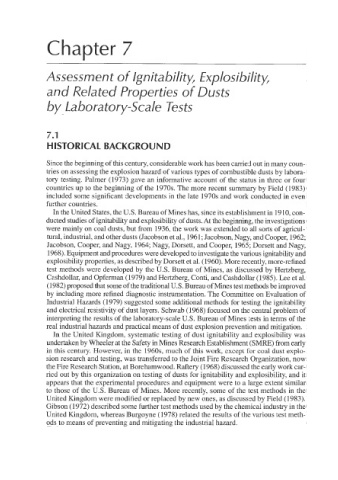Page 506 - Dust Explosions in the Process Industries
P. 506
Chapter 7
Assessment of Ignitability, Explosibility,
and Related Properties of Dusts
by Laboratory-Scale Tests
7.1
HISTORICAL BACKCROUND
Sincethe beginning of this century, considerablework has been carried out in many coun-
tries on assessingthe explosion hazard of various types of combustible dusts by labora-
tory testing. Palmer (1973) gave an informative account of the status in three or four
countries up to the beginning of the 1970s. The more recent summary by Field (1983)
included some significant developments in the late 1970s and work conducted in even
further countries.
In the United States, the U.S. Bureau of Mines has, since its establishmentin 1910,con-
ducted studiesof ignitabilityand explosibilityof dusts. At the beginning,the investigations
were mainly on coal dusts, but from 1936,the work was extended to all sorts of agricul-
tural, industrial, and other dusts (Jacobsonet al., 1961;Jacobson,Nagy, and Cooper, 1962;
Jacobson, Cooper, and Nagy, 1964; Nagy, Dorsett, and Cooper, 1965; Dorsett and Nagy,
1968).Equipment and procedures were developedto investigatethe various ignitability and
explosibilityproperties, as describedby Dorsett et al. (1960). More recently,more-refined
test methods were developed by the U.S. Bureau of Mines, as discussed by Hertzberg,
Cashdollar,and Opferman (1979) and Hertzberg, Conti, and Cashdollar (1985). Lee et al.
(1982)proposedthat some of the traditionalU.S. Bureau of Mines test methods be improved
by including more refined diagnostic instrumentation. The Committee on Evaluation of
Industrial Hazards (1979) suggested some additional methods for testing the ignitability
and electrical resistivity of dust layers. Schwab (1968) focused on the central problem of
interpreting the results of the laboratory-scaleU.S. Bureau of Mines tests in terms of the
real industrial hazards and practical means of dust explosion prevention and mitigation.
In the United Kingdom, systematic testing of dust ignitability and explosibility was
undertaken by Wheeler at the Safety in Mines Research Establishment(SMRE) from early
in this century. However, in the 1960s, much of this work, except for coal dust explo-
sion research and testing, was transferred to the Joint Fire Research Organization,now
the Fire Research Station, at Borehamwood.Raftery (1968)discussed the early work car-
ried out by this organization on testing of dusts for ignitability and explosibility,and it
appears that the experimental procedures and equipment were to a large extent similar
to those of the U.S. Bureau of Mines. More recently, some of the test methods in the
United Kingdom were modified or replaced by new ones, as discussed by Field (1983).
Gibson (1972) described some further test methods used by the chemical industry in the
United Kingdom, whereas Burgoyne (1978) related the results of the various test meth-
ods to means of preventing and mitigating the industrial hazard.

